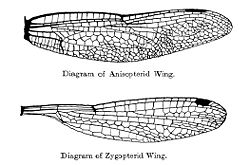Odonata
The Odonata are an order of flying insects, the dragonflies and damselflies. They are sometimes listed as the Metapterygota.
| Odonata | |
|---|---|

| |
| Aeshna juncea hovering over a pond. | |
| Scientific classification | |
| Kingdom: | |
| Class: | |
| Subclass: | |
| Order: | Odonata
|

Like most of the flying insects (flies, beetles, Lepidoptera and Hymenoptera), they evolved in the early Mesozoic era.[2] Their prototypes, the giant dragonflies of the Carboniferous, 325 mya, are no longer put in the Odonata. These are now called Protodonata or Meganisoptera.
The two suborders are easily distinguished:
- Dragonflies: they are Anisoptera (= usually larger, eyes together & wings up or out at rest)
- Damselflies: they are Zygoptera (= usually smaller, eyes apart & wings along body at rest)
All Odonata have aquatic larvae called 'nymphs', and all of them, larvae and adults, are carnivorous. The adults can land, but rarely walk. Their legs are specialised for catching prey. They are almost entirely insectivorous.
Description
These insects characteristically have large rounded heads covered mostly by big compound eyes, legs that catch prey (other insects) in flight, two pairs of long, transparent wings that move independently, and long abdomens. They have two ocelli (eye spots) and short antennae. The mouthparts are on the underside of the head and include simple chewing mandibles in the adult.[3]
Odonata Media
The giant Upper Carboniferous dragonfly ancestor, Meganeura monyi, had a wingspan of about 680 mm (27 in),
Ovipositing flight of two pairs of azure damselflies (Coenagrion puella)
Female eastern pondhawk eating a young male
References
- ↑ The Biology of Dragonflies. CUP Archive. 2018-10-13. p. 324. GGKEY:0Z7A1R071DD.
No Dragonfly at present existing can compare with the immense Meganeura monyi of the Upper Carboniferous, whose expanse of wing was somewhere about twenty-seven inches.
- ↑ Grimaldi, David; Engel, Michael S. (2005). Evolution of the Insects. Cambridge University Press. pp. 175–187. ISBN 9780521821490.
- ↑ Hoell H.V., Doyen J.T. & Purcell A.H. (1998). Introduction to insect biology and diversity. 2nd ed, Oxford University Press. pp. 355–358. ISBN 0-19-510033-6.
Other websites
 Media related to Odonata at Wikimedia Commons
Media related to Odonata at Wikimedia Commons Data related to Odonata at Wikispecies
Data related to Odonata at Wikispecies Odonata at Wikibooks
Odonata at Wikibooks- International Journal of Odonatology
- Odonata Central
- Odonatologica
- Worldwide Dragonfly Association
- [1] An unusually good account on YouTube.









